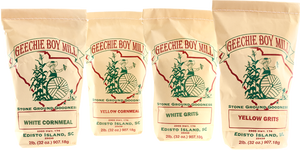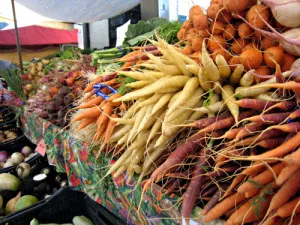GIGO
April 11, 2015
I was a management consultant many years ago, a partner in a firm that specialized in data processing consultation. I learned nothing from my partners about their specialty but I did like how they responded (privately) to the complaints of their clients.
GIGO. Garbage in; Garbage out.
I have thought about GIGO frequently over the 25 years I have spent making food as I have often had opportunities to replace the expensive ingredients I like to use with ingredients not so expensive. I know whole companies – so you do – and whole restaurant chains – so do you – that buy cheap ingredients and expect to offer good food made from inferior ingredients. But that isn’t possible.
It is possible to ruin good ingredients but it is not possible to make good food from bad ingredients; and that is why we buy the best we can find and frequently I am extravagant.
I really don’t want to use this forum as a commercial for Bread Furst. I like writing about subjects more interesting than how wonderful we are. But people say to me that being too self-effacing is self-defeating and a form of self-centeredness. And so I write this time about a subject dear to me and I hope not too boring to you.
The Washington City Paper just wrote a paean to our jambon beurre. What it said is true: It is worth the ten dollars we charge for it. I think we make a really good baguette and it makes a big contribution to the sandwich. But apart from that the sandwich is so good because we get out of its way. We spread 82 percent butter on the baguette, run a thin line of Dijon mustard down the middle, add some good Gruyere thinly sliced and slices of the hams we buy from Heritage Foods.
“Heritage Foods USA exists to promote genetic diversity, small family farms, and a fully traceable food supply. We are committed to making wholesome, delicious and sustainably produced heritage foods available to all Americans. In doing so, we will foster the link between sustainable land use, small-scale food production and preservation of the foods of past generations for future generations.”
We buy these hams every two months or so and they are delivered 500 pounds at a time by a long semi-trailer truck that can’t fit in the alley behind us.
I have a great appetite for finding ingredients for what we make and foods for our shelves. It’s a hobby; it’s fun. At the end of June I will go to New York to a gigantic food show at the Jacob Javits Center; and I will walk miles over two or three days just in the hope of finding a few new foods I want to put on the shelves.
At the winter show, much smaller, I found the distributor of cloudberry preserves and tasted Sweet Ella’s peanut butter both of which are now in our bakery.
I went to a meeting here several months ago and some young women were offering tastes of a bloody mary mix. It turned out that they make it. Dubious, I tasted it. It was really good and when I learned it is made by Gordy’s, a local small company whose pickles we don’t buy because we do our own, I asked them to bring us a case to us to sell here.
Gordy’s bloody mary mix and its cherry pepper relish are on our shelves. As are the Geechie Boy grits Tom Sietsema wrote about in his big Washington Post story this week about Charleston, South Carolina.
You can see those – as well as the butters and cheeses we select, the lingonberry preserves I used to eat at breakfast, the son of a Swedish father, the marvelous olive oil, honey, jams, and amazing yogurt being imported by the little Greek store at Dupont Circle. (The real Greek yogurt.)
What you don’t see nearly as well are the ingredients that pass from truck to our storage to be used in foods we make.
Did you know that all our flours and grains are organic? We get as much as we can locally but the bulk of our flours come from Central Milling, an employee-owned business in Utah. I started using its flours at Greystone, the Culinary Institute of America’s Napa Valley campus when I started teaching there in 1995.
Our milk comes from Trickling Springs Dairy in Pennsylvania whose “happy cows get all the sunshine and free grass they want during growing season and are not pushed in growth or production by synthetic hormones.”
Our eggs come from Earth and Eats, an Amish coop that delivers to us twice a week and our chickens come from local farms via Huntsman Specialty Game and More.
At some point in the late Nineties I discovered Alan Benton and began to buy his bacon for The BreadLine BLT. At Bread Furst we serve it in great quantities each weekend. His superb ham goes into our new country ham scone.
Some years ago at the Ferry Plaza Market in San Francisco, I came across Rancho Gordo’s dried beans, legumes we use at Bread Furst in our white bean and gigante bean salads and hummos and chili with beans (Thursday lunch). It may seem a little precious that we pay $ 980.23 for dried beans and have them sent from California but truly they are better; they have great texture and a distinctively beanier flavor.
Flavor is the point. The fun of this is finding the best ingredients we can find to make what we like making. Or even better to find wonderful ingredients and imagine recipes for them. Like the new Jerusalem artichoke salad. If they can be from local sources, that is a double pleasure. For produce, local is more or less mandatory in my scheme of things.
I am pretty rigid about being local and seasonal when it comes to fruits and vegetables and every year at this time, I wish I were living in California. My friends there send me emails about the asparagus and peas and greens they are buying at their outdoor markets. And I am here enviously reading their emails amidst the apples and butternut squash left over from the autumn.
But I think that seasonal deprivation is one way of celebrating food. I know as well as you that Chilean asparagus is available at Whole Foods. Sometimes I give in and buy eggplant there and make a dark, spicy almost wintery stew. But I really like eating with the seasons.
But it means inevitably that right now I am tired of our winter salads and you must be tired of them too.
Believe it or not spring will come and the farms on which we depend will bring us rhubarb and greens. And then Earth and Eats will run out of butternut squash (finally!) and replace it with strawberries. And Smucker Farms will have affordable greens again. And Northern Neck farm will begin to telephone us each Monday. And finally the farm stands will return to 14th and U Streets and we can tilt virtually our entire menu to what is grown in Maryland, Pennsylvania, and Virginia.
The lentils and cranberry beans will recede.
Each Saturday Robert Dalliah, our chef, and I will resume going early to the Saturday morning market at UDC and picking out what we want. At the end of the market day, those farmers will deliver boxes and boxes of vegetables and fruits they didn’t sell at retail and we’ll buy them at prices less expensive but still high.
Robert will begin to make strawberry jam and then chutney and then relishes and finally tomatoes and tomato sauces and so much more as our canning explodes (so to speak).
This produce we buy is not cheap. But to get cheap fruits and vegetables we’d have to be both anti-environment and anti-culinary and buy produce from the industrial farms of Mexico and of the Central Valley in California.
We’re not going to do that. We’ll hold out for local local fruits and vegetables even though the American addiction to agricultural subsidies makes cheaper produce grown 3,000 miles away than that which is grown 30 miles away.
Cheap is not the point, however. The point of ingredients is quality, i.e. flavor. That’s why seasonality is so important. We know when we buy that what we buy expresses what is important to us about being in the food business. So we buy what is good and as much as possible we buy what is local.






mark furstenberg, you are my idol.
Sent from my iPad
>
Informative post, thank you. Keep on doing what you are doing. I enjoy the food and the education.
Sincerely,
Susan Caporaso McBride
A loyal customer >
mark fursty proves yet again that he is a don who must be celebrated, his work and writing poured over, his passions shared. look at his family. all the furstenbergs. those sons, his sister and mother. an american treasure, these people.
This coming from the cheese guru, the father of the specialty food trade in the U.S., is a great compliment. Steve was for many, many years in charge of specialty foods at Fairway Markets in New York.
Your Passover matzo was wonderful but not as good as Breadlines. What was different?
Adrienne Sent from my iPad
>
I don’t know. It’s the same recipe made the same way. The only difference is that we are using organic flour.
Thank you, Mark!
Sent from my iPhone
>
This is from one of Washington’s most distinguished chef/restaurateurs.
The jambon beurre are wonderful and worth every penny. You and your staff keep up the great work.
The high quality of the ingredients you use can be tasted in every bite. All of the breads, pastries and salads you make are worth every penny; thank you for caring enough to only accept the best.
OK, you’ve sorta convinced to try your $8 (as I recall) granola, and maybe even le jambon beurre.
Isn’t it a bit simplistic to reduce the experience of food to its two extremes: garbage at one end and haute fare at the other? What about the vast middle ground where cooks with limited means but abundant imagination routinely produce delicious and healthful meals? That’s where the magic is! I don’t accept the notion that if I can’t afford Bread Furst I must eat garbge.
Cooks of limited means but with abundant imagination know which ingredients to select and which to avoid. Whole classes of ingredients like grains and dried beans are cheap and good. Canned tomatoes are cheap and great. Butter with lower fat content is still tasty. Lots of good ingredients are cheap and non-organic ingredients are always cheaper than organic. Cooking with lesser ingredients is harder but entirely possible.
I do believe, however, that good food cannot be made from bad ingredients; but more important, finding good ingredients is what I want to do at Bread Furst.
Thanks for the mention about our products Mark. If more chefs/owners were as committed and put as much time and effort as you do searching and researching for quality foods/ingredients DC would be eating much better…